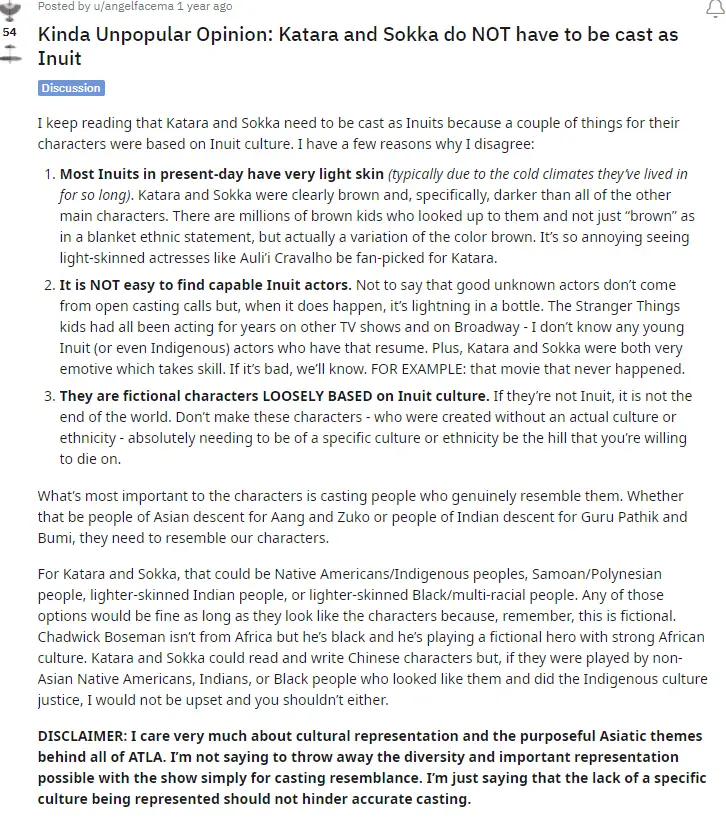This is Part One of a three-part series discussing Indigenous representation through the lens of the live-action Avatar: The Last Airbender (ATLA) cast.
As far as more diverse representation goes in media, it always feels like, especially for Indigenous peoples, a dance of two steps forward, five steps back. A glimmer of hope lays out on the horizon in shows like Echo or Reservoir Dogs (which has drawn criticism of its own with the lack of Afro-Indigenous representation in season one), and then new casting news comes out and down the ladder we go.
Case in point, the live-action adaptation of the popular ATLA series. Avatar has two prominent characters in Katara and Sokka, members of the noticeably brown Water tribe. The Water tribe itself, based on Inuit cultures, has long been one of the only positive mass media representations for Inuk persons, and yet when it comes to casting these two (Katara with a Mohawk actress and Sokka… I’m detailing all of that later), well… not an Inuit or Inuk actor in sight.
This isn’t just a Netflix problem, the same happened in M. Night Shyamalan’s much-maligned live-action feature film The Last Airbender (2010). This is a many-pronged issue. Obviously, representation is important. And yet it seems like so much of the internet has moved on beyond “representation can’t be everything” when large swaths of Indigenous communities are left behind still waiting to be represented at all. ATLA draws deep from Inuit/Inuk culture and yet will not show Inuit/Inuk actors when it comes time to adapt for a live-action medium.
Are the creators who use Inuit culture giving back to Inuit communities in a reciprocal relationship or are they profiting off Inuit culture without giving anything back?
LowArctic
Fandom’s Gonna Fandom
And, let’s not get ahead of ourselves. Non-Indigenous fandom is just as much to blame here. Even before casting was announced, members of the Avatar fandom were already absolving Netflix and the series of casting Inuit actors. In incredibly dismissive and outright racist ways.

Where to even start with this? The outright dismissal of actual Inuit people’s feelings? The incorrect assertion that “most Inuits present as light-skinned”? The absolute bonkers assumption that it’s not “easy” to find young actors and the utter handwaving of the racist reasons as to why there are no well-known Inuit child actors?
So because it’s not EASY nobody should try? It’s simply not possible? Like we don’t live in a world where Keisha Castle-Hughes, who had no prior acting experience, was plucked out of a sea of kids at age 12 to do Whale Rider and subsequently landed an Academy Award nomination for her role?
Or that there will continue to NOT be well-known actors because Hollywood casting is steeped in racism and the solution here is… giving them a pass because finding those kids who just need an opportunity to shine is “hard” and therefore they just shouldn’t have to do it? This is not something that non-Indigenous persons get to have a say in. Period. Full stop. Do not pass Go, do not collect $200.
But Kori, surely that’s just one person, you can’t judge a fandom based on one post! I’m not. Here’s a few more: One. Two. Three. Seriously, you can play whack-a-mole with these takes.
Part one of this series is solely focused on the non-casting of Inuit/Inuk actors for Katara and Sokka, the next installment is going to focus entirely on the haram casting of Ian Ousley as Sokka specifically, because… wow. Don’t worry, I’m going to be all over that.
Inuit Response
However, because part one is focusing specifically on Inuit representation and I am NOT Inuit, I wanted to be sure and reach out to someone who IS, and get their thoughts on this. So I reached out to @LowArtic, who graciously agreed to speak with me. Here’s what they had to say about this casting and Inuit representation overall:
“In anything where Inuit people, culture, or knowledge are used there are two related questions. One is representation: do Inuit see themselves on the screen in a way that respects us? The other is exploitation: are the creators who use Inuit culture giving back to Inuit communities in a reciprocal relationship or are they profiting off Inuit culture without giving anything back?
“When [it] was first released the Avatar series checked a lot of boxes in terms of representation. The Water Benders aren’t Inuit but in incorporating Inuit culture, a lot of Inuit kids could see themselves on screen in a way that was respectful and nuanced. Having some representation in a fantasy and martial arts series was just plain cool because Avatar was the first. And having a series that includes Inuit characters that exist in a world with other communities of color but doesn’t revolve around white people was also pretty new. But obviously, that representation falls apart if you don’t actually have Inuit actors when you make a live-action series whether it was the movie or the upcoming Netflix series.
“Avatar was the first in many ways which is why a lot of Inuit kids who grew up with it like it a lot, but also it demonstrated that including Inuit cultures in a positive and respectful way really works and can be fun and popular. So for me, it showed that media should expand on that and create reciprocal relationships that are more reciprocal with Inuit communities, hire more Inuit actors, writers, and elders, and allow Inuit to be the storytellers instead of white people or non-Inuit. The Avatar franchise as a whole hasn’t really delivered on that. Bryan Konietzko and Michael Dante DiMartino left the production because of the casting issues which as we now know are very flawed, but I haven’t seen anything that suggests their future projects will have the kind of reciprocal relationship I would like to see.”
Positive Inuit Representation
This doesn’t mean there aren’t any media at all for Inuit peoples. That is absolutely not the takeaway I want readers to leave with. LowArctic also provided examples of projects from Inuit creators that I strongly encourage anyone who reads this to go and check out:
Aviaq Johnston’s books Those Who Run in the Sky and the sequel Those Who Dwell Below.
Upper One Games and E-Line Media’s puzzle-platform, Never Alone (Kisima Ingitchuna), was released in 2014 and is based on the traditional Iñupiaq tale, “Kunuuksaayuka”, which was first recorded by master storyteller Robert Nasruk Cleveland in his collection Stories of the Black River People. The game was a result of the partnership between the Cook Inlet Tribal Council and E-Line Media, and included Indigenous representation in the production process.
Inua: A Story in Ice and Time from The Pixel Hunt, IKO, and ARTE France is an adventure game based on the Franklin Expedition that drops February 10th, and included an Inuit writer and Inuit advisors.
Next time…
Coming soon in Part Two, I’ll be analyzing Ian Ousley’s casting, as well as the response from the three federally recognized Cherokee tribes. Buckle up.
Image courtesy of Nickelodeon
Have strong thoughts about this piece you need to share? Or maybe there’s something else on your mind you’re wanting to talk about with fellow Fandomentals? Head on over to our Community server to join in the conversation!


